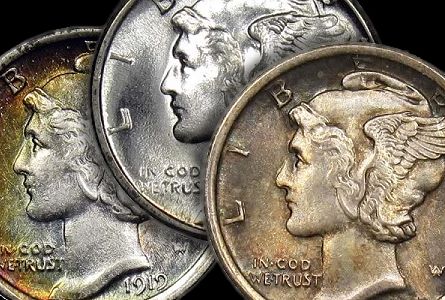By Al Doyle for CoinWeek …..
Mention Mercury dimes in collecting circles, and a few dates come to mind. Rather than automatically locking in on the 1916-D, 1921, 1921-D and the 1942/1 and 1942/1-D overdates, it might be a better idea to check out the many semi-keys that seem to be neglected.
Pre-1934 “Mercs” such as the 1917-D, 1919-D and -S, 1923-S, 1924-D and 1925-D aren’t available in significant quantities. That applies to both circulated examples in Very Fine or better as well as Mint State pieces with or without fully split bands. For collectors who enjoy a challenge, here’s something that will take effort whether $20 or $500 coins are involved.
Although they aren’t as wildly popular as Lincoln cents, Morgan dollars and Buffalo nickels, the Mercury series is sought by numerous collectors. That means partial sets in blue Whitman holders are bought over the counter by coin shops on a regular basis.
 One trend becomes apparent when these purchases are examined. The vast majority of pre-Depression pieces show considerable wear and other undesirable traits such as clumsy attempts at cleaning. These scruffy specimens may be suitable as hole fillers, but they aren’t the kind of material desired by savvy numismatists.
One trend becomes apparent when these purchases are examined. The vast majority of pre-Depression pieces show considerable wear and other undesirable traits such as clumsy attempts at cleaning. These scruffy specimens may be suitable as hole fillers, but they aren’t the kind of material desired by savvy numismatists.
Collecting Short Set Mercury Dimes Produced from 1940-1945
Whether the goal is to assemble a nicely matched circulated date set or to aim higher into the Mint State spectrum, the goal won’t be achieved overnight as can be done with the 18 “short set” Mercurys of 1940 to 1945; eBay provides some idea of relative scarcity.
Sticking with coins encapsulated by CAC, NGC, or PCGS (typically in MS-62 or better), there were eight 1928-dated pieces and 239 dimes struck in 1944 listed on July 10 along with six 1927 Mercs and 201 pieces struck at various mints in 1943. That works out to a 31.43 to 1 ratio of newer dates versus older. In reality, the 1940s dimes are even more common than indicated on eBay, as the low cost of the later dates means many vendors won’t bother with an online auction at selling time.
The situation is equally lopsided in circulated grades.
Dimes of 1940 to 1945 are abundant to the point of being tossed in junk silver buckets (hint: this is a great way to accumulate 90 percent). The occasional piece from the ’20s can be found in these batches, but they tend to be quite worn. Don’t hesitate to sift through the silver bucket at the local coin shop, as some older Mercury dimes in the Very Fine to Extra Fine range can be cherrypicked. Persistence does have its rewards.
Aside from such rare bits of good fortune, the date set collector is going to have to grind it out and obtain the desired pieces one or two at a time through conventional means.
Collecting pre-1934 Mercury Dimes is Challenging, but P-Mint Coins Are Affordable
The first rule of pre-1934 Mercury dimes is that (much like Buffalo nickels) P-mints tend to be somewhat more common and affordable than their branch mint counterparts. To cite some typical examples, the 1918 that is listed for $15 in Extra Fine and $100 in MS-63 is less than half the cost of the 1918-S at $35 and $250 in the same grades. The 1924 Mercury is easy on the wallet at $15 in EF, but the price soars to $70 for the 1924-S in the same condition. A price spread of nearly 6 to 1 ($650 vs. $110) exists between those dates in MS-64.
It’s natural to want to obtain coins in the upper tier of the condition spectrum, but the cost of certain Mercury dimes means crunching the numbers is essential to deciding on the desired grades. If collecting “circs” seems to be a lowly pastime at first glance, give it a try, and you’ll find that semi-key Mercurys can be challenging area.
Mintage figures such as 6,440,000 for the 1923-S or 4,161,000 for the 1928-D are one factor in 21st century availability, but it goes beyond how many pieces were originally struck. Many branch mint dimes came off the presses with less than the sharpest details and glowing luster. How many of these semi-keys entered circulation out of sheer necessity during the Great Depression and were used up?
The 1926-S (1,520,000 struck) is the king of the semi-key Mercs. With a mintage that is just a bit above the perennially popular 1921 and 1921-D, this is a coin with more than a little appeal. Combine the small original mintage with much attrition in circulation over the years, and it’s not hard to understand why the Coin World values jumps from $35 in Fine to $325 in Extra Fine. Better plan on a four-figure purchase for the 1926-S in MS-63 or better.
If sleepers appeal to you, consider the 1925-D. The mintage of 5,117,000 provides a clue about the date’s relative scarcity, but try and find a few nice examples of this date before assuming it’s just another slightly interesting Roaring ’20s coin. An uncleaned VF for around $50 is a classic example of what is sometimes referred to as a “real collector coin”.
The 1931-dated Mercury dimes are something of a historic trio. Since no quarters, half dollars, silver dollars or commemorative half dollars were struck in this economically bleak year, these 10-cent pieces were the only silver coinage created in 1931 by the U.S. Mint.
Even with a modest mintage of 3.15 million, the 1931 was produced in greater numbers than the 1931-D (1.26 million) and 1931-S (1.8 million) combined. The threesome can be obtained for $35 to $100 total in VF and EF, and many numismatists have sufficient funds to pursue these Depression-era keepsakes in the uncirculated grades.
Who Graded the Coin Matters
One final word of caution: Stick with semi-key Mercurys that have been certified by a major third-party grading service when the price gets much above $100. This is especially true for better dates with fully split bands, as a little coin doctoring with a razor can make an ordinary piece appear to have the desired feature.
Whether a person wants to dabble with a few lower-priced dates or go all out, pre-1934 Mercury dimes are miniature artistic masterpieces that can be elusive with above average eye appeal. It’s a collecting challenge for any budget.





Good list. I would have to add or include the 1926-S. My fave sleeper Merc, is the mentioned 1919D.